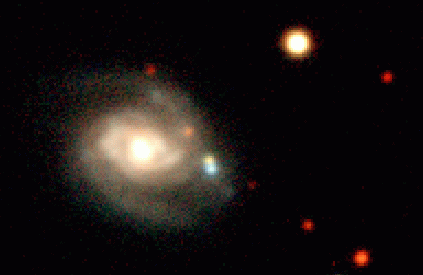
|
Credit & Copyright:
C. Hergenrother,
Whipple Observatory,
P. Garnavich, P.Berlind, R.Kirshner
(CFA)
Explanation:
Long ago in a galaxy far, far away,
locked in their final desperate struggle against the force of gravity ...
two stars exploded!
Stellar explosions - Supernovae - are
among the most powerful
events in the Universe, estimated to
release an equivalent energy of up to
1 million trillion trillion (1 followed by 30 zeros) megatons of TNT.
After the explosion, an expanding supernova envelope
is observed to brighten over a
a period of days to a maximum light output
which rivals that of an entire galaxy before
fading from view over the following months.
Triggered by the collapsing core of a massive star or the
nuclear demise of a white dwarf
supernovae occur in average spiral galaxies
only about once every 25-100 years.
But a recent observation of NGC 664, a spiral galaxy about 300 million
light years distant, captured a rare and colorful performance -
two supernovae from the same galaxy.
In this monitoring exposure the two supernovae,
one reddish yellow and one blue, form a close pair
just below the image center (to the right of the galaxy nucleus).
The color difference is due to temperature -
blue is hotter.
|
January February March April May June July August September October November December |
| ||||||||||||||||||||||||||||||||||||||||||||||||
NASA Web Site Statements, Warnings, and Disclaimers
NASA Official: Jay Norris. Specific rights apply.
A service of: LHEA at NASA / GSFC
& Michigan Tech. U.
Based on Astronomy Picture
Of the Day
